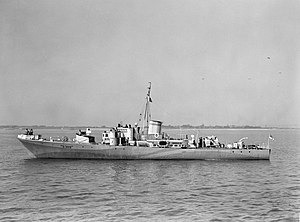Steam Gun Boat

Grey Goose
|
|
| Class overview | |
|---|---|
| Name: | Steam gun boat (SGB) |
| Operators: | RN |
| Built: | 1940-1942 |
| In service: | Nov 1941- post-war |
| Completed: | 7 |
| Active: | none |
| Lost: | 1 |
| General characteristics | |
| Displacement: | 175 tons (standard), 255 tons (deep load) |
| Length: | 44.3 m (145 ft 8 in) overall |
| Beam: | 7.1 m (20 ft) |
| Draught: | 1.68 m (5.5ft) |
| Installed power: | 8,000 shp (5,965 kW) |
| Propulsion: |
|
| Speed: | 35 kn (65 km/h) maximum |
| Range: |
|
| Complement: | 27 initially (3 officers and 24 men), later rising to 34 as a result of changes in armament |
| Armament: |
|
Steam gun boat (SGB) was a Royal Navy term for a class of small naval vessels used during the Second World War. The class consisted of nine gun boats, powered by steam, and built from 1940 to 1942 for the Coastal Forces of the Royal Navy.
They were developed in parallel with the Fairmile D motor torpedo boats ("dog boats"), specifically as a response to the need to hunt down German E-boats and also as a response to the scarcity of suitable diesel engines. While sixty were planned only an initial batch of nine were ordered on 8 November 1940, of which seven were completed.
The steam gun boats were conceived to answer the seeming need for a craft which was large enough to put to sea in rough weather and which could operate both as a 'super-gunboat' and a torpedo carrier, combining the functions of the Motor Gun Boat (MGB) and Motor Torpedo Boat (MTB) in the same fashion as did the German E-boats. The Admiralty wanted Denny to produce a design that was suitable for pre-fabrication construction to enable large numbers to be built.
They were the largest of the Coastal Forces vessels, and were the only ones to be built of steel (to meet the fast production requirement - all other Coastal Forces craft were of wood). They resembled a miniature destroyer, and were perhaps the most graceful of all the craft produced during the Second World War. However their comparatively large silhouette was a drawback, making them too easy a target for the faster German craft.
They were 145 ft 8 in (44.40 m) long and had a displacement of 172 tons (202 tons fully fuelled). They were powered by two 4,000 hp steam turbines using special flash boilers. These boilers proved to be particularly vulnerable to attack and - once the vessel had broken down - required a major effort to repair. Steam had the advantage of quietness but demanded a large hull. Large wooden hulls were not feasible for mass production so steel was used. This meant hulls and machinery were beyond the scope of the small yards engaged in the rapid expansion of the coastal forces, and the SGB thus competed for berths in yards already hard put to produce urgently required convoy escorts. Also they competed in the demand for mild steel and steam power plants against the more urgently demanded destroyers; accordingly the planned 51 further vessels were never ordered, while the two units ordered from Thornycroft were never begun due to enemy action. The seven vessels actually completed were built by Yarrow, Hawthorn Leslie, J. Samuel White and William Denny and Brothers, entering service by the middle of 1942.
...
Wikipedia
